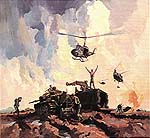Tracks Magazine - August 1955


A couple of decades ago I was travelling through northern NSW and called in to see Archie McDonald, an old 1 Armoured Regiment LAD mate. Archie had kept his copy of the first issue of the Regiment's glossy magazine, Tracks — August 1955. It is this magazine that is re-produced below
Tracks Magazine
Index
Foreword Preface Principles of Employment of Armour Tracks To Tradition Keep An Open Mind Review of Squadron Activities Regimental Headquarters Headquarters Squadron Reconnaissance Troop A Squadron Notes B Squadron Notes Nucleus Squadron Regimental Training Troop Light Aid Detachment, RAEME Signals Troop, RASigsIndex (cont)
Review of Allied Armour Korean Sidelights Equipments 1954 .. A Royal Occasion On Parade Elevating Gear Officers' Mess Notes Sergeants' Mess Notes In The Realm of Sport It Could be You The Adjutant's Dilemma While Others Sleep [et al] Beauchamps Own Epilogue Free Verse From A Free Thinker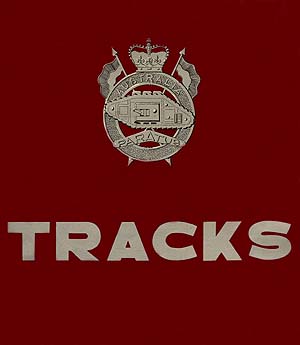
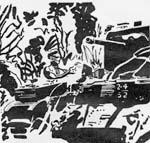
Tanks in the Jungle
Our contributor saw active service with Australian Armour in Jungle Warfare, and later served in the First Armoured Car Squadron in Japan.
Australia's accepted commitment in South-East Asia once again brings jungle warfare to the forefront. Australian troops during World War II were outstanding for their success in the jungle, but little has been said of the part played by the tanks.
Historic Action by Tanks
Typical of the many actions in which tanks were engaged, the following extract from The History of the 2/4 Australian Armoured Regimental Group will show how successfully they were used.
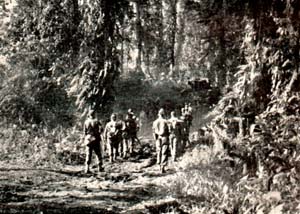
"In the early hours of the 5th April, 1945, Bn. H.Q. and a company of 25 Bn., which were in position on Slater's Knoll, were subjected to a very heavy attack by the Jap. In spite of heavy fire from our position and our 25-pounders, he attacked right up to the perimeter wire, which was cut in many places. By dawn he had dug in on the edge of the clearing outside the wire and was covering our position. Another attack was made during the morning, but was quickly beaten back. However, from the fire that was coming at our infantry it was evident that there was a very large party of Japs involved, and it was realised that if the wire was not repaired by nightfall they would almost certainly overrun the position. Attempts by our men to move out to repair the fence were met by a fusillade of shots from about thirty yards away.
"The C.O., 25 Bn., asked for two tanks to move through the perimeter wire and to fire across the front of the wire, where all the Japs were dug in. When the tanks opened up with B.E.S.A. and two-pounder H.E., they blasted the jungle away, leaving no cover for the Jap. Then followed a most amazing spectacle, resembling a rabbit shoot in warren country. The Jap, devoid of cover and within about thirty yards of our nearest weapon pits, decided it was time to make a break for cover behind him. As each man showed himself there would be a 'tally-ho' from our infantry and dozens of weapons — Brens, rifles, Owens — would open up on him. All the time tanks were searching the ground with fire, ferreting out any survivors.
"At the end of an hour there was no more sign of live Japs and the infantry moved out to mop up. In all, 307 Japs were buried on and below Slater's Knoll after the day's operations, and no one knows how many crept away and died in the jungle nor how many were wounded and evacuated.
"Later P.W. reports showed that some 1,800 Japs were involved in these attacks on 25 Bn., and approximately 1,000 casualities were inflicted on them — a remarkably successful turn of events, for 25 Bn. were facing annihilation until the tanks came up to their assistance. However, all praise is due to the infantry who unflinchingly stood up to vastly superior members of enemy and did not give ground."
A Just Recognition
It is satisfying to see the use of tanks in jungle is appreciated, and the Regiment is being reorganized to participate in this type of warfare. Unfortunately this was not so in the early part of the island campaign in World War II, when hard lobbying was required before tanks were finally committed.
Comments on Service Conditions
Crewmen. — Basically, the lot of the crewman is similar in this type of warfare to that for which we have been training. Because of the difficult terrain, heavy jungle, incessant rain, tropical diseases and lack of communications, his standard of efficiency must be extremely high.
Crew Commander. — The crew commander, because of the closeness of the country, must be ever alert and must be prepared to accept conditions which under normal conditions would not prevail. He must be flexible in his mind and, in addition to being a tank commander, must be fully conversant with the requirements of an infantry section leader.
Troop Leader. — The troop leader in most cases in jungle will find it essential to fight his tanks from the ground, because of the extremely close co-operation required with the infantry and the limited visibility of tank crews. He, therefore, as well as being a troop leader, must also be at least as efficient as a platoon leader.
Difficulty of Terrain — Engineer Co-operation. — It is safe to say tanks cannot move in the jungle for any great distance without the assistance of engineers. In the past it has been found that the engineer team is required to be equipped with a bulldozer to break down banks of rivers and creeks, and some cases to force a new track through virgin jungle. Experiments have been carried out with tank dozers, but they did not prove very successful. The limited visibility does not allow the same exacting work as can be obtained with the normal dozer.
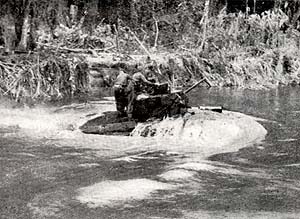
Waterproofing. — A tank crew must be ever ready to carry out waterproofing. Rivers and creeks are met frequently. They are swift running, of a speed up to eight knots, generally with reasonably solid beds of a depth with is fordable by tanks. However, because of the swiftness of flow even in the shallowest of rivers the water will tend to build up against the side of tanks, and if not waterproofedwill be swamped. Because of poor roads, or lack of them, many times it may be found convenient to move tanks by landing craft; once again tanks require to be waterproofed otherwise there is always a possibility of "drowning" one.
In mentioning landing craft, just as practice is required in loading and off-loading transporters, the same applies to the loading and off-loading of landing craft.
Targets and Gunnery. — The indication of targets is an extremely difficult task because of the dense growth. Many times the best one can do is indicate the general area. The machine gun when fired in many cases will cut down the soft undergrowth, and so give better visibility to the gunner. Somewhat expensive on ammunition, however it has the desired effect. In using the main armament the possibility of tree bursts has always to be considered, particularly when it is normal for infantry to be right up with the tanks. Whilst on gunnery, a problem would appear to arise with the 20-pounder gun, because of its length traversing of the gun must be restricted in jungle. Many times in an advance along a track or in "scrub bashing" the width of the track will be no wider than the tank itself.
Vehicle Recovery. — The debogging of tanks is an ever-recurring task, and one which must be accepted, for on many occasions it is impossible to tell whether the going will take a tank or not. It may be necessary on many occasions to assist the engineer team to lay corduroy, and during the last war, 200 yards of corduroy was not uncommon. It is, therefore, an asset to be adept at the swing of an axe.
Crew Conditions. — Probably one thing that is near to a tankman is his "brew" — electric heaters and petrol stoves are all nice refinements, but many times one is forced to use the every-day fire, with the wet wood this presents difficulties. The alternative was a fruit tin filled with sand, soaked with fuel oil, which when ignited burnt at a reasonably slow rate and gave off great heat.
The prevalence of skin diseases, heat and humidity in jungle makes the wearing of heavy tank overalls undesirable. Garments which are light, cool and easily washable are preferable.
A Past Lesson and a Future Hope
It is interesting to recall that during the last war if the Jap knew that tanks were within an infantry perimeter he seldom mounted an attack. This factor alone always made the tanks welcome to the infanteer.
The value of tanks in jungle warfare has been proven with machines far inferior to our present equipment. The use of the Centurion, because of its size, may cause difficulties not already encountered, however these would not be insurmountable — the success gained in any future actions should be immeasurable.
Tankman Turns Footslogger
"Australian tankmen at Bougainville regarded their machines as human, and spoke to them in terms of endearment. At least they did when things went well, but sometimes they did not go well," wrote Bob Nelson. "Along the Buin Road an Australian Matilda Tank about to fire upon the Japs on each side of the track ahead, stewed into a ditch and was bogged. There were a few moments of silence, then the lid (sic) of the tank was thrown up, and a Digger, purple faced with rage got out, stood with his hands on his hips and addressed the tank. 'You stupid .... Four .... years we waited to get a smack at the .... and when we get 'em you go and stick your nose in a ditch. You stupid....' With that he planted a well-placed kick between the Matilda's tracks."
